Changing Priorities for ’02
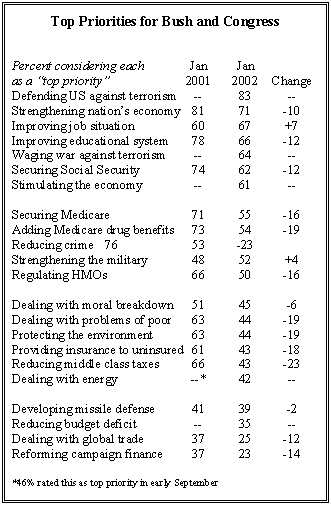 Sept. 11 and the war against terrorism have had a dramatic impact on the public’s policy priorities. Many of the concerns that were rated highly in previous January surveys — crime, tax cuts, poverty, the environment, health care and retirement programs — have fallen in importance. Even education, which led the list of priorities from 1997 to 2000 and ranked second last year, has slipped a bit this year.
Sept. 11 and the war against terrorism have had a dramatic impact on the public’s policy priorities. Many of the concerns that were rated highly in previous January surveys — crime, tax cuts, poverty, the environment, health care and retirement programs — have fallen in importance. Even education, which led the list of priorities from 1997 to 2000 and ranked second last year, has slipped a bit this year.
Not surprisingly, the public’s leading concern is defending the nation against future terrorist attacks — 83% rank that as a top priority. About seven-in-ten (71%) view strengthening the economy as a top priority and nearly as many (67%) say the same about improving the job situation.
While the war and sagging economy have been the biggest factors in reordering the list of priorities, developments in the policy arena may have contributed as well — in the past year, the president and Congress have agreed on major education and tax cut legislation. About two-thirds of Americans (66%) rate education as a top priority, down from 78% last year, while middle-class tax cuts have fallen even further (23 points).
In addition, several health-related issues, which were given far lower prominence by the Bush administration than under former President Clinton, had declined in importance even before the Sept. 11 attacks. Last January, 73% said that adding a prescription drug benefit to Medicare was a top priority; in an early September poll by the Pew Research Center (which did not cover the complete list shown here), 60% viewed it as a top priority. That number has fallen to 54% in the current survey. Regulating health maintenance organizations (HMOs) has shown a comparable decline — from 66% in January to 54% in early September and 50% currently.
Post-9/11 Policy Differences
Republicans and Democrats both rank defending the nation against terrorism and bolstering the economy as urgent priorities, but they sharply disagree — as they have in past years — over the importance of other domestic objectives.
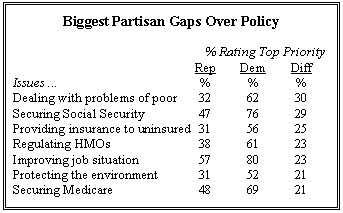 The biggest differences come on traditional Democratic concerns, helping the poor and securing Social Security. Nearly twice as many Democrats as Republicans (62%-32%) view helping the poor as a top priority for Bush and Congress. About three-quarters of Democrats (76%) rate Social Security as a top priority, while just 47% of Republicans agree. There are also wide gaps on health care, jobs, Medicare and the environment.
The biggest differences come on traditional Democratic concerns, helping the poor and securing Social Security. Nearly twice as many Democrats as Republicans (62%-32%) view helping the poor as a top priority for Bush and Congress. About three-quarters of Democrats (76%) rate Social Security as a top priority, while just 47% of Republicans agree. There are also wide gaps on health care, jobs, Medicare and the environment.
Democrats attach greater importance than Republicans do to most policy priorities. Even developing a missile defense system — a traditional GOP issue — is regarded as a high priority by more Democrats than Republicans (46%-38%). Democrats also are more likely than Republicans to view reducing the budget deficit as a top priority (41%-27%).
Republicans place a greater priority than Democrats on security-related issues (except missile defense) and dealing with the nation’s moral climate. More than two-thirds of Republicans (68%) rate strengthening the nation’s defenses as a top priority, compared with half of Democrats. Republicans are more likely to view the war against terrorism abroad as a major priority (73%-61%), and attach greater importance than Democrats to dealing with the nation’s moral breakdown (54%-44%).
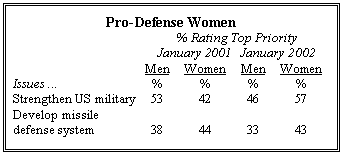 As in past years, there is a gender gap on many domestic priorities, with more women than men giving high priority to addressing poverty, health care, the environment, education and Medicare. In the wake of the Sept. 11 attacks, the gap also now includes defense — fully 57% of women view strengthening the nation’s defense as a top priority, compared with 46% of men. That is a shift from a year ago, when more men than women gave high priority to bolstering defense.
As in past years, there is a gender gap on many domestic priorities, with more women than men giving high priority to addressing poverty, health care, the environment, education and Medicare. In the wake of the Sept. 11 attacks, the gap also now includes defense — fully 57% of women view strengthening the nation’s defense as a top priority, compared with 46% of men. That is a shift from a year ago, when more men than women gave high priority to bolstering defense.
In addition, women attach greater importance than men to building a missile defense system, although that was also the case last year. Since Sept. 11, support among women for missile defense has grown dramatically; in October, 51% of women favored immediate deployment of a missile shield, up from 29% in early September (see “America’s New Internationalist Point of View,” Oct. 24, 2001).
Foreign Policy Lags
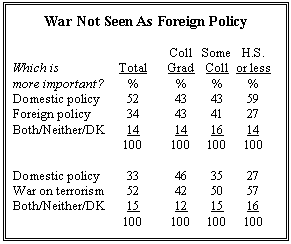 While the war on terrorism is the highest single priority on Americans’ minds, it is seen as distinct from traditional foreign policy issues. When asked whether the war on terrorism or domestic policy is more important, roughly half (52%) cite the war, while a third say domestic policy. However, when the choice is between foreign policy and domestic policy, these numbers are reversed, with 52% citing domestic policy as the more important priority, and 34% choosing foreign policy.
While the war on terrorism is the highest single priority on Americans’ minds, it is seen as distinct from traditional foreign policy issues. When asked whether the war on terrorism or domestic policy is more important, roughly half (52%) cite the war, while a third say domestic policy. However, when the choice is between foreign policy and domestic policy, these numbers are reversed, with 52% citing domestic policy as the more important priority, and 34% choosing foreign policy.
Better educated people are more apt to give equal priority to domestic and foreign policy, and are more likely to give domestic policy its due even in light of the war on terrorism. For those with less education, the war on terrorism holds clear precedence over domestic policy, while foreign policy is seen as far less important than domestic.
GOP Leads On Key Issues
The Republican Party is seen as having the best ideas for dealing with terrorism and the economy, which rate as the public’s leading priorities for 2002. Over the past year, Democrats have increased their lead on health care and retirement programs — but those issues have declined in importance.
The GOP holds a substantial edge in handling terrorism, both abroad and at home. By more than three-to-one (51%-16%), Americans believe Republicans have the best ideas on dealing with terrorism overseas. Even Democrats, by 41%-27%, choose the GOP as the party with the best ideas on combating foreign terrorism. The Republican lead on dealing with terrorist threats at home is nearly as large (48%-18%), although Democrats are more evenly divided on this (32% say Republicans, 28% Democrats).
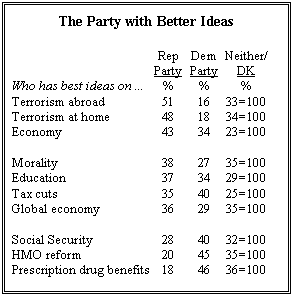 Perhaps owing to President Bush’s strong rating on the economy, the Republicans also hold a 43%-34% lead on that issue. Over the past decade, public confidence on this issue has gone back-and-forth between the parties. As recently as May 2001, a small plurality expressed more confidence in the Democrats’ ability to keep the country prosperous. The current survey shows a deep partisan split on this issue — 74% of Republicans say the GOP has the best ideas on the economy, while 61% of Democrats opt for their party. Independents favor the Republicans on dealing with the economy, 45%-30%.
Perhaps owing to President Bush’s strong rating on the economy, the Republicans also hold a 43%-34% lead on that issue. Over the past decade, public confidence on this issue has gone back-and-forth between the parties. As recently as May 2001, a small plurality expressed more confidence in the Democrats’ ability to keep the country prosperous. The current survey shows a deep partisan split on this issue — 74% of Republicans say the GOP has the best ideas on the economy, while 61% of Democrats opt for their party. Independents favor the Republicans on dealing with the economy, 45%-30%.
Republicans also draw continuing support on education, formerly a Democratic strong suit, as a result of Bush’s persistent efforts to highlight that issue. The two parties are at parity on education, as they were last January. Partisans are deeply divided on which party has the best ideas on education, while independents are evenly split.
The issues on which Democrats have the biggest advantage are the ones they have promoted for years — providing prescription drugs under Medicare, where they hold a 46%-18% lead, and regulating HMOs (45%-20%). In addition, 40% of Americans credit the Democrats with having the best ideas on securing Social Security, while 28% choose the Republicans. Perhaps more surprising, the Democrats hold a slight 40%-35% lead on cutting taxes for the middle class, which, along with education, is Bush’s signature issue.
The Democrats also have cut into the GOP’s lead as the party with the best ideas on improving the nation’s morality. A year ago, the public chose Republicans by nearly two-to-one (49%-26%); now, the GOP’s edge is 38%-27%. Women, who had preferred Republicans on this by a wide margin (45%-28%), now are more closely divided (33% favor Republicans, 27% Democrats).
Surge in Economic Optimism
Americans clearly expect that the economy will bounce back soon. They are dramatically more optimistic about prospects for the U.S. economy than they were when the president was about to take office.
 In what may be another sign of the “rally effect” that has boosted satisfaction with national conditions, 44% of Americans say they expect economic conditions in the country to improve in the coming year, while just 17% expect things to get worse. A year ago, almost twice as many Americans expected things to get worse rather than to improve (33% vs. 18%).1
In what may be another sign of the “rally effect” that has boosted satisfaction with national conditions, 44% of Americans say they expect economic conditions in the country to improve in the coming year, while just 17% expect things to get worse. A year ago, almost twice as many Americans expected things to get worse rather than to improve (33% vs. 18%).1
But when considering their personal financial situations, Americans are only somewhat more hopeful than they were at the beginning of the Bush administration. Today, 65% expect an improvement in their families’ finances during the coming year, compared with 57% last January (a low point not seen since the year George Bush Sr. was voted out of office). This modest increase in optimism was evident in June, well before the terrorist attacks.
Republicans and independents are much more optimistic than Democrats over prospects for reviving the nation’s economy. A solid majority of Republicans (55%) expect the economy to improve, while just 8% think it will get worse. Independents are also upbeat, with 45% anticipating an improvement and 14% believing it will go down. Democrats are more gloomy: just 34% expect an upturn, while 24% say conditions will worsen. In terms of their personal finances, Democrats are also somewhat less optimistic than Republicans or independents.
Younger Americans are more likely than their elders to expect improvement in their personal fortunes — fully 83% of those under age 30 say their financial situation will improve — although they are no more likely than older Americans to say the U.S. economy will improve.
Americans are evenly divided about the cause of the nation’s economic downturn. About as many cite the terrorist attacks (48%) as attribute blame to the normal ups-and-downs of the economy (46%). Interestingly, there is virtually no partisan split regarding the cause of the downturn. Although Republicans are much more likely to think the economy will improve soon, both Republicans and Democrats are nearly evenly split about what they think caused the slump. And there is no link between the cause Americans cite for the downturn and their optimism about prospects for a recovery.
Bush’s Mixed Grades for Effort
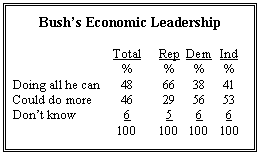 It is clear that the broad popular support for the president extends to his stewardship of the economy. By roughly two-to-one (60% to 28%), more Americans approve of the way Bush is handling the economy. At the same time, many express reservations about Bush’s dedication to dealing with economic issues. Nearly as many people say that the president could be doing more to help the economy (46%) as say he is doing all he can (48%).
It is clear that the broad popular support for the president extends to his stewardship of the economy. By roughly two-to-one (60% to 28%), more Americans approve of the way Bush is handling the economy. At the same time, many express reservations about Bush’s dedication to dealing with economic issues. Nearly as many people say that the president could be doing more to help the economy (46%) as say he is doing all he can (48%).
Not surprisingly, partisanship plays a large role in these evaluations. While most Democrats (56%) think Bush could be doing more to help the economy, just 29% of Republicans agree. But the perspective of independents is much closer to the Democratic than the Republican position. Better than half (53%) of independents think Bush could be doing more.
Meanwhile, there is considerable interest, even among Democrats, in Bush’s upcoming State of the Union address. A majority of Democrats (52%) see this year’s speech as more important than previous efforts. That is more than double the number of Democrats who viewed Bill Clinton’s final State of the Union speech as particularly important (21%). Among Republicans, not surprisingly, interest has skyrocketed. Nearly two-thirds (65%) say Bush’s speech is more important than previous efforts, compared with just 10% who said that about Clinton’s address in 2000.
Democratic Changing of the Guard
While the terrorist attacks clearly boosted President Bush’s job approval, the events of the fall have had, at best, a minor effect on evaluations of the Democrats. Today, about half the public (54%) approves of the job the Democratic leaders in Congress are doing, up from 49% prior to the Sept. 11 attacks.
Moreover, the public’s verdict on Clinton’s presidency remain largely unchanged from March 2001. Currently, just over half of Americans say Clinton will turn out to have been either one of the best presidents (12%) or better than most (39%), while a quarter say he was not as good as most presidents and 19% say he was definitely worse than most.
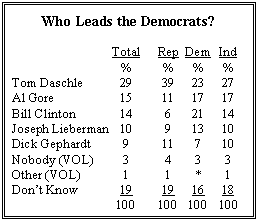 The Clinton-Gore era is gradually fading from the public’s consciousness, as a new Democratic leader moves into the spotlight. Senate Majority Leader Tom Daschle’s recent visibility is clearly pushing him to the forefront of the Democratic party in the public’s eye, particularly among Republicans.
The Clinton-Gore era is gradually fading from the public’s consciousness, as a new Democratic leader moves into the spotlight. Senate Majority Leader Tom Daschle’s recent visibility is clearly pushing him to the forefront of the Democratic party in the public’s eye, particularly among Republicans.
Fully 39% of Republicans consider Daschle to be the leader of the Democratic party, more than twice the number that cite either Al Gore or Bill Clinton. There is less consensus among Democrats, but Daschle’s stock has risen dramatically there as well. In April of last year, just 5% of Democrats listed Daschle as the party’s leader; today 23% do, slightly more than the number who choose Clinton (21%) or Gore (17%). Sen. Joe Lieberman runs a close fourth among Democrats, followed by House Minority Leader Dick Gephardt.
Better educated and older Americans, groups that tend to follow the news closely, are the most likely to see Daschle at the forefront of the Democratic Party. Americans over age 30 are twice as likely as those who are younger (32% to 15%) to see Daschle as the Democratic leader, while 18-29-year-olds are the most likely to list Gore (27%) or Clinton (20%). More than half (53%) of college graduates see Daschle as the key figure in the Democratic Party, compared with 27% of those who attended some college and just 18% of those who never attended college.
A New Political Climate?
Reflecting the public’s generally positive assessments of both Bush and the Democratic leadership in Congress, more Americans express optimism about a cooperative political environment in Washington in the coming year. Just over half (53%) say they think Republicans and Democrats will work together more to solve problems, up from 41% in January 2001.
Similarly, the share of Americans who think the parties will bicker and oppose one another more than usual has fallen from 50% last year to 39% today. Among the minority who expect more partisan bickering, comparable proportions lay the blame on either the Republican Party (10%), the Democratic Party (11%), or both equally (12%).
 Democrats, in particular, have developed an improved image of Washington politics over the past year. A year ago, following Gore’s bitter defeat, Democrats were markedly more cynical about partisan cooperation (56% predicted the parties would bicker and oppose each other more than usual) than were Republicans (41%). Today, Republicans and Democrats have similar outlooks — 56% in each party see cooperation, while 37% expect conflict. Though independents also have a better view of Washington than they did at this time last year, they remain more pessimistic about the possibilities for cooperation than either Democrats or Republicans.
Democrats, in particular, have developed an improved image of Washington politics over the past year. A year ago, following Gore’s bitter defeat, Democrats were markedly more cynical about partisan cooperation (56% predicted the parties would bicker and oppose each other more than usual) than were Republicans (41%). Today, Republicans and Democrats have similar outlooks — 56% in each party see cooperation, while 37% expect conflict. Though independents also have a better view of Washington than they did at this time last year, they remain more pessimistic about the possibilities for cooperation than either Democrats or Republicans.
Women, who were predominantly pessimistic about cooperation in Washington a year ago, also have changed their view dramatically. Today, six-in-ten women see the parties working together over the next year, with a third predicting partisan bickering. Men are much more divided (47% see cooperation, 44% bickering).
And younger Americans have a more positive outlook than they did last year. Those under age 50 express higher job approval of both Bush and Democratic Congressional leaders than their elders, and are significantly more likely to think the tone in Washington will be positive over the next year. A year ago these younger respondents were, if anything, more pessimistic than those age 50 and older.
While this expectation of cooperation between the parties clearly reflects the new political pressures of the post-Sept. 11 world, it may also be linked to a somewhat different view of the president’s position within his own party. A year ago, a plurality of Americans (48%) thought President-elect Bush listened mostly to the conservative wing of his party. Today, just 38% hold this view, with 40% saying he listens more to moderate members of his party. This reevaluation of Bush has occurred among Republicans, Democrats and independents alike, although more Democrats than Republicans see Bush as more attentive to conservative voices.
Cable News Gets Terrorism Boost
Cable news has become the leading source for national and international news in the post- 9/11 news environment. Overall, television remains the overwhelming choice as the public’s main source of news: 82% of Americans say that is where they get most of their news, up 8% from pre-9/11 levels. Newspapers (42%), radio (21%) and the Internet (14%) fall far behind television as primary news sources, and received no boost over the past four months.
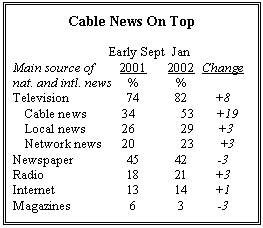 The higher proportion citing television in general reflects a surge in the number relying on cable news sources. More than half of Americans (53%) say they get most of their news from the major cable news channels, significantly fewer cite network (23%) or local TV news (29%).
The higher proportion citing television in general reflects a surge in the number relying on cable news sources. More than half of Americans (53%) say they get most of their news from the major cable news channels, significantly fewer cite network (23%) or local TV news (29%).
The rise of cable news as a source of national and international news is directly attributable to the public’s heavy reliance on cable for information on terrorism. The current figures on media use are comparable to results from mid-September and mid-November, when respondents were asked specifically where they got most of their news about terrorist attacks and the war on terrorism. The proportion citing cable news as a main source for national and international news has risen 19% since before the Sept. 11 attacks, when cable news held a narrower lead over local and network news as a primary source of information.
The public’s preference for cable news channels is also seen in increasingly positive assessments of their performance. When asked which media have done the best job covering the news, nearly four-in-ten (38%) cite cable TV news, more than twice the number saying that about network news (16%), and about three times the number rating local TV news (13%) or newspapers (10%) as best. This represents a seven-point increase from January 1999 in the percentage citing cable news as superior, while all other news sources either stayed the same or received less support. Cable news gets its strongest ratings from younger men, those living in the South, and people in small towns and rural areas.
Few Aware of Buddy’s Death, Argentina Crisis
 Reflecting continued public disengagement from international affairs even after Sept. 11, as many Americans knew the name of the former president’s dog killed in a traffic accident (Buddy) as could identify the Latin American nation mired in political and economic turmoil (Argentina). In both cases, about a quarter of the public (28%) came up with the correct response.
Reflecting continued public disengagement from international affairs even after Sept. 11, as many Americans knew the name of the former president’s dog killed in a traffic accident (Buddy) as could identify the Latin American nation mired in political and economic turmoil (Argentina). In both cases, about a quarter of the public (28%) came up with the correct response.
Men were more likely than women to correctly identify Argentina, while men and women were equally aware of the name of President Clinton’s dog. College graduates, online users and those who follow the news closely were much more likely than others to come up with the right answers.
War Tops News Interest Index
Roughly half the public (51%) is following news of the U.S. military campaign in Afghanistan, which represents a modest increase in interest in that story since December (when 44% followed it very closely). Interest in the U.S. military effort has now matched its highest level, reached in mid-October.
Three-in-ten followed reports about the condition of the U.S. economy very closely this month. This number has been declining steadily since mid-November, when about four-in-ten paid close attention.
Tensions between India and Pakistan garnered the close attention of less than a quarter of the public (23%). In June 1998, many more Americans (36%) said they had closely followed reports that the two nations had tested nuclear weapons.
Only slightly fewer people (20%) paid close attention to the trial of a Massachusetts man accused of beating another father to death during a youth hockey practice. One-in-five also closely tracked reports on the failed suicide bombing of an American Airlines jet coming from Paris. Reports on the collapse of Enron drew a comparable level of interest. At the bottom of the January news interest index was economic and political instability in Argentina, with just 5% of the public following this story very closely. Even those who paid close attention to other major news stories showed little interest in the ongoing crisis in Argentina.


